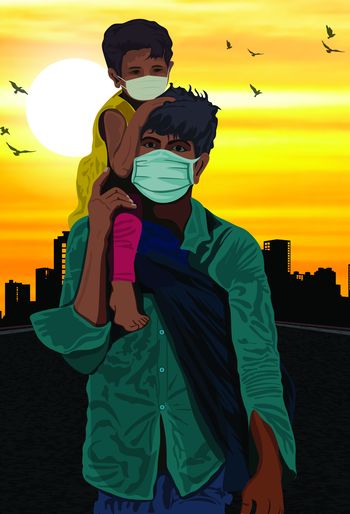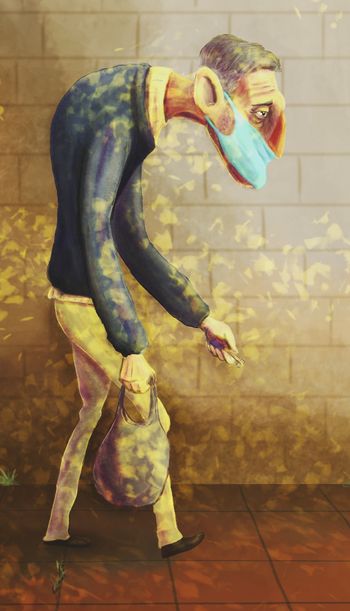At some point in late 2019, an outbreak of a novel SARS-like coronavirus was detected in Wuhan and reached the level of a global contagion. Where did it come from?
Did it spill over naturally from a bat to humans? Did it originate in a wet market in Wuhan? Or is there any truth in the “conspiracy theory” that the virus slipped out of a laboratory in Wuhan where active research on SARS-like coronavirus was being conducted? Or, the thorniest question of all, could it have been genetically modified or tinkered with? In recent months, the debate has been reignited.
What really happened? At this stage it seems that nobody knows for sure. Very little is known about the beginnings of the pandemic, but everything indicates that the first outbreak of the virus appeared in Wuhan. The trillion-dollar question is: how did it get to Wuhan?
There are multiple paths it could have taken, and to explain the turn of events, two theories have emerged. One school of thought assumes it is a natural zoonotic event. The other school of thought assumes that it escaped from a nearby research laboratory that studies and works with exactly this kind of coronavirus. (Some opine that it was a bioweapon, and purposefully released—but I don’t think that any reasonable person espouses this belief. Equally absurd is China’s favourite theory that the virus SARS-CoV-2 reached China on frozen goods from abroad.)
As for the first theory, there are a range of possibilities including a zoonotic jump from bats to humans, either directly or via an intermediate host. This is not beyond the realm of possibility. This is what happened with SARS and MERS. However, with SARS and MERS, scientists were able to determine rather quickly which animal species had carried the virus from bats to humans. SARS had also escaped laboratory containment on at least four occasions. For SARS-CoV-2, a year and a half has passed without any intermediate species or precursor virus being identified.
Under the second theory, there are several scenarios, including an accidental spillover due to some lapse in safety protocols (sometimes confused with the theory of a man-made virus). This spillover could have come either from an original virus that had been kept for study, or from a virus that was genetically manipulated in a laboratory. (Such manipulation is usually a matter of making some changes to an existing virus, either by introducing mutations into the virus, or by inserting proteins that can help it more readily infect humans—and it is reasoned that such research helps test drugs and potentially devise vaccines.)
On the surface, there might seem to be a significant counter-argument to the genetic modification theory: no telltale signs of manipulation in the SARS-CoV-2 genome have been detected. Yet this observation does not negate the argument. In the past, older methods of genetic modification showed traces of manipulation. But newer methods, known as ‘no-see-um’ or ‘seamless’ technology, leave no signatures of manipulation—nor do other techniques of virus manipulation such as serial passaging in humanised animal cells or lung cells. (Serial passaging is the name given to a laboratory method that “teaches” the virus to better adapt to other cell types. That is, it accelerates the process of evolution of a virus in a host.)
There is no definitive evidence either way. Both theories are still on the table, and theoretically, it could be both—a lab escape of a natural-origin virus. However, what is striking is that only one of these two avenues of potential inquiry has been discredited as a “conspiracy” from the outset, and that alone is worthy of attention.
Two coronavirus research institutes being within a driving distance of the first documented outbreak is, to say the least, suspicious, and warranted further investigation. So why was a lab leak so difficult to accept as a possibility, and one highly probable at that? Some of the answers can be found in two letters in prestigious journals early on—one in The Lancet, the other in Nature Medicine —which set the tone of the global debate.
The Lancet letter was initiated and organised by Peter Daszak, the president of EcoHealth Alliance, with which many of the signatories are connected. Among the signatories were Rita Colwell and James Hughes, who are on the board of directors of EcoHealth Alliance; William Karesh, its executive vice president; and Hume Field, its scientific and political adviser. This is the same organisation that had acted as an interface between the Wuhan Institute of Virology's (WIV) research programmes, the US National Institute of Health (NIH) and the US Agency for International Development (USAID).
The tone of the letter was insistent: “We stand together to strongly condemn conspiracy theories suggesting that COVID-19 does not have a natural origin.” (When did the conspiracy theory even have the chance to be debunked? Why could it not be investigated scientifically, without recourse to emotional language?) Financial and reputational conflicts of interest, which would have been obvious to most readers, were not declared in this letter. On the contrary, the letter concluded: “We declare no competing interests.” At the time of writing, this letter in its current form still remains in breach of basic standards of scientific publishing.
The letter in Nature Medicine played a major role in discrediting the lab origin theory by making assurances that this was a natural zoonotic spillover, without any evidence to support this claim. With these two letters the debate was gradually consigned to the margins—before it even took place. Others shunned it because of its connection to President Donald Trump. For the media, the theory likely became an article of political faith, rather than a scientific quest. From that moment, the lab leak theory increasingly seemed to be a case of pariahs pitted against reasonable, scientific people. The theory largely disappeared from scientific and media discussion for a year. Even mentioning the suspicion that Covid-19 may have accidentally leaked from a laboratory in Wuhan was tantamount to insanity. That is, until recently.
After almost a year, in a letter to Science magazine, eminent members of the scientific community dared to articulate their dissatisfaction with the imbalance in the attention paid to the lab leak theory, and expressed the need for a “transparent, objective, data-driven” investigation. The genie was out of the bottle.
THE LAB LEAK THEORY
If we were going to theorise a ‘laboratory scenario’, what kind of data do we have? First of all, the location: Wuhan is not a spillover zone for SARS-like viruses (SL-CoV). The nearest phylogenetically-related bat coronaviruses are over 1,600km from Wuhan, and bats were hibernating around the time of the outbreak. The only place where bats are known to have been kept in the city of Wuhan was at the virology labs themselves.
What is also known is that none of the animals in the animal market were found to be positive for SARS-CoV-2. On the other hand, Wuhan is home to at least two institutes that research bat coronaviruses, collecting samples in the field and bringing them to Wuhan for research purposes. The obvious question seems to be this: is it a coincidence that a novel coronavirus appeared in the very city where two coronavirus research institutes are located? You don’t have to be a mathematician to say that the probability of such a coincidence is microscopically small. However, the oddities don’t end there.
To understand better why the lab leak theory is now attracting so much attention, we have to jump back in time a few years. Like an exciting suspense thriller—but real unfortunately—the trail leads us to cases of a mysterious illness that occurred in 2012, in Mojiang county, Yunnan province, China.
THE SIX MINERS OF MOJIANG
One of the mandates of the Wuhan Institute of Virology was to investigate potential sources of pandemic pathogens. Flashback to 2012, when six miners who were cleaning an abandoned mine in Tongguan, in Mojiang, fell sick with an unexplained form of pneumonia. Three of them died. The illness of these six miners sent alarm bells ringing among the Chinese authorities, who had gone through a brief SARS epidemic ten years before. Scientists from multiple virology labs, including WIV, China’s Center for Disease Control and labs from Beijing, were called in to investigate the mine. (For some reason, the Chinese government did not report the incident to the World Health Organization at that time. The cases didn’t even make it into the official China CDC statistics. Why?)
What followed, however, was years of intense bat sampling missions. Within a few years, scientists from WIV had collected samples from thousands of bats from the site. More than half of the samples tested positive for coronaviruses. Multiple other viruses were detected in bats, and one of them was Ra4991, whose RdRp sequence is almost identical to SARS-CoV-2 (98.9%). The research was led by Shi Zhengli, who published the results in 2016 in the journal Virologica Sinica. However, she did not mention the cases of sick miners.
The study was funded by three NIH grants and the funds were channelled through EcoHealth Alliance.
Shi Zhengli received the first of these grants in 2012 for Discovery, isolation, identification, distribution, genetic evolution, and pathogenicity of human pathogens carried by bats (Grant number 81290341). In 2013, just two months before Shi Zhengli sampled Ra4991 from the mine, she received another grant to Investigate Viral Pathogen Profiles in Some Natural Hosts and Vectors in China (Grant number 2013FY113500). In October the same year, Shi Zhengli published a scientific article in the journal Nature in which she showed for the first time that it is possible for SARS-like viruses to jump directly from the bat to humans, without the need for an intermediate host.
In 2014, one of Shi Zhengli’s students, Wang Ning, wrote an academic thesis, in which the virus carried by bats in the infamous mine was investigated. It noted: “It’s likely that the six miners were infected with the pathogen carried by bats.” In the same year, WIV received a renewal of funding from the NIH, specifically to work on the SARS-like viruses collected in South China—and to investigate the routes of infection to humans (Grant number R01AI110964).
In June 2019, Yu Ping, a student of Shi Zhengli, full genome sequenced Ra4991, and characterised an entirely new lineage of SARS-like CoVs comprising nine coronaviruses from the mine closely related to SARS-CoV-2.
Fast forward to January 2020, a month after the first known cases of Covid-19 were identified. This is when Shi Zhengli published a full genome sequence—from a library of unpublished sequences—of the closest match to SARS-CoV-2, namely RaTG13. She did so without specifying where it originated, or what triggered the sampling in that mine. Nor did she cite her own 2016 paper.
There was a rational reason to study the mine—SARS was a big deal in the early 2000s. And why wouldn’t China’s leading research centre for SARS-like coronaviruses study a site associated with six cases of SARS-like pneumonia? They had every motivation to look into these after the first SARS outbreak, which was traced to a cave near Kunming. Their goal? Hunting for prospective bat coronavirus candidates which could attack through the human ACE-2 receptor.
PUZZLE PIECES CONVERGE
In early 2020, it took a few scientists and internet sleuths to correlate the sequence identity of RaTG13 with that of a short bat coronavirus fragment, Ra4991. The latter had been uploaded to the GenBank database in 2016, obtained from the same mine where six miners fell sick with the SARS-like illness. In May 2020 the connection between the Mojiang miners and WIV was finally established, with the unearthing of a master's thesis written by Dr Li Xu, one of the doctors of the Kunming Medical University.
The thesis described in detail the diagnosis, treatment and the probable cause of illness of the six miners. It summarised the cases to be “caused by SARS-like CoV or bat SARS-like coronavirus that has been isolated from the Chinese rufous horseshoe bat”. Symptoms were identical to what we now call Covid-19, including high fever, respiratory problems, cough, body pain, thromboembolism, hypoxia and organ failure. CT scans showed similar signs as many Covid-19 patients have today.
The next puzzle piece came from a 2016 PhD thesis written by Huang Canping, a student of Gao Fu, the current director of China CDC (who will play a prominent role, for various reasons, throughout the story). In addition to what was already known, this document clearly states that WIV had tested the four miners (two had died by then); and all four of them had tested positive for SARS-like antibodies. (However, in a 2020 interview with Scientific American, Shi Zhengli claimed that the miners died of a fungal infection, and that no coronavirus had been involved. Why?)
Only after the sequence identity of RaTG13 with Ra4991, and the connection to the unexplained pneumonia outbreak had been pointed out several times, did Shi Zhengli and her team clarify this—nine months later—in November 2020, within an addendum to their original article. In this addendum, her team also revealed two additional years of sampling of the mine, and the fact that they had fully sequenced the genome of RaTG13 in 2018.
It is remarkable, therefore, that despite these glaring discrepancies in the narrative of WIV, the media still seemed convinced of the narrative, consistently playing down even the possibility of a lab leak.
It is indicative that even a year and a half after the outbreak of the pandemic, no closer relative of SARS-CoV-2 has been found. So there are good reasons to investigate the mine for clues about the origin of the virus.
America’s top infectious disease expert, Anthony Fauci, has asked China to disclose all information —including medical records about the sick miners —noting, “It is entirely conceivable that the origin of SARS-CoV-2 was in that cave and either started spreading naturally or went through the lab.”
VIRUS HUNTING
Since 2009, USAID has conducted a large-scale pilot project on identifying emerging pandemic threats, called PREDICT. They do this by collecting samples from virus habitats, sequencing their genomes, but also by manipulating them, in order to understand the mechanisms by which viruses can be transmitted from animal hosts to humans. The field research was largely organised by EcoHealth Alliance. In the next ten years of the PREDICT project, which ran up to September 2019, EcoHealth Alliance collaborated with WIV on the investigation and characterisation of a large number of bat coronaviruses throughout China. The research, in fact, allowed the identification of coronaviruses from the Mojiang mine.
In the freezers of this particular laboratory, it is estimated that there is one of the largest inventory of bat virus samples on the planet. (Over the past few years, WIV and its associates collected more than 15,000 bat samples from all over China, including at least 1,322 samples from the Mojiang mine.)
DISEASE X
Since 2015, the WHO has been publishing a list of potential pathogens that could trigger a pandemic. The list, which is updated every year, includes Ebola, Marburg, Zika, Lassa fever, Congo-Crimean fever, SARS, MERS, Nipah and Rift Valley fever—deadly diseases for which there is no cure or effective vaccines. The WHO wanted to stimulate research for drugs and vaccines against them.
In 2018, for the first time, a certain 'Disease X' was added to the list, a disease still unknown, but capable of causing the next pandemic. To combat this threat, in 2018, scientists launched the Global Virome Project (GVP), an international initiative promoted by USAID and funded by numerous agencies and governments. The project aimed to identify, map and catalogue roughly 1.6 million undiscovered viruses that reside in mammals and birds, and learn about the viruses that can potentially infect humans. Dennis Carroll, Peter Daszak, Jonna Mazet and Gao Fu were among the leading figures of the Global Virome Project.
The project had begun to take shape in 2016 in Bellagio, Italy, at a meeting organised by the University of California-Davis and USAID. In early 2017, they met again in Beijing to implement the associated China Virome Project. The cornerstones of the project were published in the journal Science in 2018, in which the authors affirmed: “Funding has been identified to support an initial administrative hub, and fieldwork is planned to begin in the first two countries, China and Thailand.” The authors also noted that “leaders in China and Thailand have begun developing national virome projects as part of the GVP, leveraging current research funding to include GVP sites”.
Since the fall of 2018, the China Virome Project has been working on the listing of all potential pandemic viruses in China. According to its promoter Gao Fu, “Scientists will collect virus samples from animals such as bats and rats for study using techniques like next generation sequencing” to identify the viruses, and “thoroughly study those that could pass to humans”. In addition, he said, “Ideally we can develop vaccines and a diagnosis for such viruses even before they cause human epidemics.
“EcoHealth Alliance is committed to the GVP... The hope is that we can learn everything to know about Disease X before it strikes,” Daszak explained. “We are about to start initial work in China... the project could also be attractive for pharmaceutical companies because it could allow them to anticipate viruses and target them more broadly.”
The Wuhan Institute of Virology, in addition to having collaborations with EcoHealth Alliance, was one of the key sites of the Global Virome Project. In 2018, representatives of the US embassy in China visited WIV and sent official diplomatic cables to Washington. According to them, “Institute officials expressed strong interest in the Global Virome Project (GVP), and said Chinese funding for the project would likely come from Chinese Academy of Sciences (CAS).” They further noted: “Other countries... are skeptical on whether China could remain transparent as a “gatekeeper” for this information.”
They also raised doubts about the observance of biosafety rules in Wuhan. “The new lab has a serious shortage of appropriately trained technicians and investigators,” warned the diplomats. In another US state department cable released by USRTK in May, the diplomats wrote, “Shi Zhengli... stated that CAS has already allocated funding for GVP-related research.”
In a semi-annual report published in 2019, it is stated: “PREDICT developed specific maps for... the China Virome Project and presented these... in high-level meetings with Chinese Government and US embassy leaders in Beijing... these analyses will form the basis for the design of specific work plans in both countries during the rollout of their virome projects in 2019-20.” These included bat colonies in South China including Yunnan.
(The latest PREDICT report, released in December 2020, is conspicuously silent on this project. Why?)
In May 2019, Weifeng Shi, a researcher from Shandong First Medical University, posted a job listing mentioning the “China Virome Project and novel pathogen discovery”. That’s the last we heard of the project. (Curiously, this group of scientists would later publish some of the close known relatives of SARS-CoV-2: RpYN06 and RmYN02.)
On May 2020, just after the pandemic spread, Peter Daszak gave an interview, in which he revealed exactly what they had in plan: “We found the closest relative to the current SARS-CoV-2 in a bat in China in 2013. We sequenced a bit of the genome, and then it went in the freezer; because it didn’t look like SARS, we thought it was at a lower risk of emerging. With the Global Virome Project, we could have sequenced the whole genome, discovered that it binds to human cells and upgraded the risk. And maybe then when we were designing vaccines for SARS, those could have targeted this one too, and we would have had something in the freezer ready to go if it emerged.” It couldn't be clearer—but there’s a problem: contrary to Daszak’s claim, RaTG13 wasn’t forgotten in the freezer. WIV had actually characterised the whole genome of RaTG13 in 2018.
The CAS “Special Project”
In the fall of 2018, Chinese Academy of Sciences approved a “Special Project” titled, “Pathogen Host Adaptation and Immune Intervention”. The project was led by Gao Fu. The project description states, among other things, “Clarify the source and transmission mechanism of the pathogens of emerging and sudden infectious diseases such as influenza and SARS... provide a theoretical basis for vaccine development and clinical treatment...”
The “Special Project” was divided into five subprojects, and Shi Zhengli was the person in charge for Project 1: Research on virus traceability, cross-species transmission, and pathogenic mechanism. A paragraph in the project description reads: “For patients with unexplained disease… conduct unknown pathogen detection and pathogen group research to explore and identify pathogens with potential risks of infecting humans and animals... study their ability to invade different host cells and their ability to replicate in different host cells, analyze the key molecules affecting their cross-species infections... Develop new vaccines and… focus on... realizing the industrialisation of 1-2 application results.” Imagine that—industrialising such results.
The idea was to radically change the approach—move from a reactive strategy, to a proactive strategy that allows anticipating the next threats by characterising the viruses that can potentially jump to humans, with their declared goal being to design therapies and vaccines.
Moreover, on September 1, 2019, just before the pandemic spread, a summary meeting of the CAS “Special Project” was held. The five research teams reported on the “achievements made in the past year, and key scientific issues in the future”. According to the researchers, “some influential and major scientific research results have been achieved”. This is where the trail fades. The project vanished into thin air, like, no trace at all.
HOW A CHIMERIC CORONAVIRUS IS MADE
There are various ways in which the SARS-CoV-2 virus might have developed into a form that could first gain the potential to infect humans, and then reach the point of efficiently adapting to the new human host. Such gain of function, in principle, can arise through natural recombinations, but another pathway is via human intervention, in the form of artificial manipulation of the genome.
In this respect, it is important to note the type of experiments that were carried out in Wuhan. In a 2017 doctoral thesis, Reverse Genetic System of Bat SARS-like Coronaviruses and Function of ORFX, the Wuhan Institute of Virology pioneered the technique of creating chimeric coronaviruses “without leaving any trace sequences (e.g. incorporated enzymatic sites) in the recombinant viral genome”. In other words, they leave no signs of manipulation.
The paper details the methodology and, in passing, it notes, “determining in the laboratory whether recombination occurs after co-infection with different SL-CoV strains and what new strains may arise from recombination is beneficial for studying the evolutionary pattern of SL-CoV and providing a basis for preventing possible future outbreaks of SARS-like diseases.”
The study, in which the experiments were conspicuously done in BSL-2 labs, culminates by looking forward to newly emerging methods: “yeast recombination or in vitro recombination… applied to the reverse genetics of coronaviruses could develop a more efficient and economical method... for the development of antiviral drugs, for basic virology research, etc.”
This begs the question, what has happened, in the meantime, to this fundamental line of research? Did WIV expand and build on this technique? The doctoral thesis does not prove that it did, yet does provide a strong indicator that manipulations may indeed have been carried out… without leaving a trace.
WIV RESEARCH PROJECTS
As already mentioned, WIV was working on SARS-like coronaviruses, with state grants from the USA and China. Since 2018, the laboratory has been involved in (at least) four more key research projects:
1. Study on the evolutionary mechanism of bat SARS-like coronavirus adapted to host receptor molecules and the risk of cross-species infection (Project number 31770175). In other words, it investigated the evolution of SARS-like viruses and studied its potential to cross the species barrier.
2) Pathogenicity of two new bat SARS-related coronaviruses to transgenic mice expressing human ACE-2 (Project number 31800142). This project tested “two new SARS-like coronaviruses” by infecting humanised mice to assess their spillover potential to humans.
3) Genetic evolution and transmission mechanism of important bat-borne viruses (Project number XDB29010101). This project examined the type of changes in the genome required for different bat viruses to be able to make the leap over to other mammals—and also infect humans.
4) Understanding the Risk of Bat Coronavirus Emergence (Project number R01AI110964-05 and -06). From the 2018 project abstract itself, we know that WIV was “experimentally using reverse genetics, pseudovirus and receptor binding assays, and virus infection experiments across a range of cell cultures from different species and humanized mice.” The 2019 contract stipulates: “We will fully characterise natural SARSr-CoV diversity in southern China. We will sequence receptor binding domains (spike proteins) to identify viruses with the highest potential for spillover which we will include in our experimental investigations... We will use S protein sequence data, infectious clone technology, in vitro and in vivo infection experiments and analysis of receptor binding to test the hypothesis that % divergence thresholds in S protein sequences predict spillover potential.”
After the outbreak of the pandemic, the NIH withdrew the funding for the project. In emails to EcoHealth Alliance, Michael Lauer, the NIH's deputy director for extramural research, suggested that the Wuhan lab had “not satisfied safety requirements under the award”. To address the NIH’s concerns, he asked EcoHealth Alliance to “explain why WIV failed to note that the RaTG13 virus, the bat-derived coronavirus in its collection with the greatest similarity to SARS-CoV-2, was actually isolated from an abandoned mine where three men died in 2012 with an illness remarkably similar to COVID-19, and explain why this was not followed up.” In another email, Lauer wrote to Daszak: “We need to know all sites in China that have been in any way linked to this award.”
You wonder what kind of experiments were carried out in the intervening period regarding these projects. What did they achieve? And what (if there are any) relationship could such research have to do with the Covid-19 pandemic? These questions may never be answered, but the facts demonstrate a lot: in the run-up to the Covid-19 pandemic, WIV continued to perform the kind of research which had long been extremely controversial among virologists.
The research was cutting edge, but it also meant that such research carried a potential-risk of a pathogen escape.
WHAT WE KNOW
We can summarise the landscape with the following panorama:
* Covid-19 was detected in the same city as China's leading research centre for SARS-like coronavirus.
* There were no bats or pangolins for sale at the time of the outbreak. As for wild bats, just a year before the pandemic outbreak, the lab under scrutiny obtained a patent for cages for "breeding bats in artificial conditions."
* It only took a few months to find the intermediate host for SARS and MERS, but despite advances in disease surveillance and tracing since then, we were one year and six months too late for SARS-CoV-2. (Perhaps scientists haven't found an intermediate host because one doesn't exist, or it's a laboratory animal, or perhaps even a transgenic animal model using human ACE-2 receptor.)
* WIV had gathered a huge collection of samples from a mine linked to SARS-like cases. Starting 2018, the institute was running potentially dangerous experiments designed to test the infectivity of SARS-like viruses, and their transmission between species.
* The lab has been reluctant to provide information on the viruses it has been working on. WIV's virus databases, which contained data on more than 22,000 viruses, have been taken offline by Chinese authorities. Critical data such as case histories of the first cases, wastewater samples and blood samples were also withheld. Nor have they shared raw data, log books or laboratory records on its extensive work on SARS-like coronaviruses.
* Most of the coronavirus research was done in BSL-2 or BSL-3 laboratories, i.e., less than ideal safety conditions. Two years before the outbreak of the pandemic, major safety issues were documented within the facility.
* Scientists had been warning us of a potential pandemic induced by human error, and that the need for, and safety of, this research should be under serious scrutiny.
* Once Chinese authorities learned of the outbreak, they failed to correctly communicate the seriousness of the situation, and this stalled the entire world’s ability to respond effectively or to contain the epidemic.
* Major media outlets and scientific journals dedicated themselves to repeating and reinforcing the same positioning evident in the letters in The Lancet and Nature Medicine. For a time these letters seemed to effectively close the debate.
* The WHO was not able to investigate the theory of lab leak. It had to rely on the information provided to it by Chinese scientists who were under the control of the state, and who did not make any raw data available. WHO team members also appear to have taken assurances from lab workers at face value, and then recommended little in the way of follow-up action investigation—in short, a seeming absence of the search for the truth. Even the WHO director was unsatisfied with the insufficient effort given to the lab leak theory, and has called for a more detailed investigation to be done.
* All studies on the origin of the virus were, and are, subject to special review by the Chinese ministry and must be officially approved in order to be published.
All in all, there is a significant link in the chain of evidence yet to be investigated. This includes evidence of obfuscations, omissions and inconsistencies in the data provided by WIV. For the record, none of this is to say that there is a definitive evidence of a lab leak, but these phenomena cannot be ignored or overlooked when trying to ascertain exactly what did happen. It also means that obsessively asserting the impossibility of a virus emerging from a laboratory —as the scientific and media establishment did throughout 2020—does not meet the most basic standards of journalistic or scientific inquiry.
Considering the known circumstances, and the timing and the type of research they were engaged in, the question whether the pandemic arose because of gross human mishandling of a virus, which then assumed Dantesque proportions, is a valid question to ask. It is also time to demand answers.










